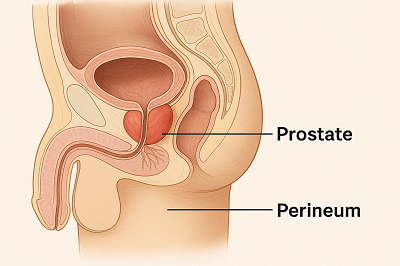Can Traditional Chinese Medicine (TCM) Relieve Perineal Pain Caused by Prostatitis?
At men's health clinics, it's common to encounter patients complaining of dull, heavy pain in the perineal area—often worsened by prolonged sitting and disruptive to daily life. This is a hallmark symptom of prostatitis, a common urological issue in men. But why does prostatitis cause perineal pain? And can TCM help alleviate it? Let's explore this from both anatomical and traditional Chinese medicine perspectives.

How Prostatitis Leads to Perineal Pain
Anatomically, the prostate lies deep within the pelvis, shaped like an inverted chestnut, positioned near the bladder and rectum. It's separated from the perineum by only a thin layer of soft tissue. When inflammation occurs, the prostate becomes congested and swollen, compressing nearby nerve endings and releasing inflammatory substances such as prostaglandins and interleukins. This can result in a persistent burning or heavy sensation.
In chronic inflammation, prolonged nerve stimulation increases sensitivity in the sacral nerve plexus. Around half of these patients also develop protective spasms in their pelvic floor muscles, creating a vicious cycle of "pain → muscle tension → more pain." Continuous muscle contraction not only impairs blood flow but also irritates the perineal nerves, with pain often radiating to the lower back, groin, or testicles.
From the TCM perspective, factors like sedentary lifestyle, spicy foods, and emotional stress can lead to damp-heat accumulation in the lower body. This results in poor circulation and blockage of energy (Qi) and blood flow in the prostate area, causing localized stabbing or heavy pain. TCM sees this as a reflection of both local symptoms and systemic imbalance.
TCM Strategies for Managing Prostatitis-Related Pain
Promoting Blood Circulation and Removing Stasis
TCM focuses on resolving blood stasis, a root cause of chronic prostatitis pain. Herbal ingredients like Danshen (Salvia miltiorrhiza) contain tanshinones that dilate blood vessels and promote microcirculation—akin to unclogging blocked pipes. Chuanxiong helps regulate Qi, relieve pain, and reduce blood viscosity, making it particularly effective for stabbing sensations. Peach kernel, often used alongside safflower and red peony root, works to soften prostate tissues and reduce nerve pressure.
Clinical studies show that these herbs can significantly lower levels of inflammatory markers in prostatic fluid, addressing pain at its source.
Clearing Heat and Draining Dampness
For patients with damp-heat patterns, herbal agents that clear heat and drain dampness are essential in addition to promoting circulation. Phellodendron and sophora root have natural antibacterial properties, helping to ease burning urination. Plantain seed and Alisma help eliminate excess heat and dampness through urination, reducing symptoms like urinary frequency and urgency.
Formulas such as Qianlie Shutong Capsules combine heat-clearing, damp-draining, and blood-activating properties, making them ideal for chronic prostatitis or prostate enlargement caused by damp-heat obstruction. The Diuretic and Anti-inflammatory Pill, a proprietary herbal remedy, integrates antibacterial, anti-inflammatory, blood-activating, pain-relieving, diuretic, anti-proliferative, and anti-calcification effects. It is suitable for all types of prostatitis and delivers comprehensive symptom relief.
Multimodal Therapies for Synergistic Pain Relief
TCM also offers external therapies to build a multi-layered pain management system. Herbal sitz baths made with sophora, frankincense, and myrrh promote local blood circulation through warm water immersion, allowing herbal compounds to penetrate the prostate region while also relaxing pelvic muscles. Acupressure on points such as Guanyuan, Qihai, and Huiyin helps regulate energy flow and relieve nerve tension.
Acupuncture, another cornerstone of TCM, has been shown to modulate the excitability of the sacral nerve plexus. Clinical data indicate that needling points like Sanyinjiao and Taichong can reduce pain scores by over 30%.
Lifestyle Adjustments: The Other 70% of Recovery
TCM emphasizes the principle of "30% treatment, 70% self-care." Lifestyle modifications are crucial for sustained pain relief. Sitting puts 2–3 times more pressure on the prostate than standing. It's advisable to stand and stretch every 40 minutes to promote pelvic circulation. Spicy foods, alcohol, and irritants can exacerbate damp-heat, while cooling and circulation-promoting foods like winter melon, coix seed, and black fungus are recommended.
Regular sexual activity is also important. Prolonged abstinence can lead to prostatic fluid retention, while excessive ejaculation may cause glandular congestion. Most men benefit from ejaculating 1–2 times per week based on their age and health status.
Additionally, maintaining good perineal hygiene, avoiding late nights, and reducing pressure-inducing activities like cycling are key strategies to prevent pain recurrence.
So, Can TCM Truly Relieve Perineal Pain from Prostatitis?
Whether viewed through the lens of modern neurology or ancient TCM theories of Qi and blood, the answer is yes. TCM alleviates pain not only by improving microcirculation and reducing inflammation, but also by regulating the body's internal balance. Through a combination of herbal medicine, external therapies, and lifestyle guidance, TCM breaks the vicious cycle of "inflammation → pain → anxiety" and helps restore both physical comfort and emotional wellbeing.



